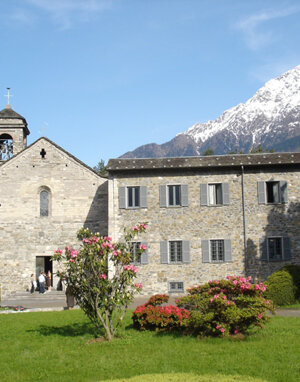Larihome by Casartelli Francesco
Privacy - Cookie policy
Piona Abbey
PIONA ABBEY


The Abbey of Piona, or more precisely the Priory of Piona, a typical building of Comacina art in exposed squared stone, also reachable from the lake by boat, is a rare jewel of Lombard Romanesque architecture.
Located on the Olgiasca peninsula, opposite Gravedona, at the far tip of the Lecco branch, it offers a splendid panoramic view of the western coast of the Lario, as well as the opportunity to enjoy the tranquility and peace experienced by the Cistercian monks who still live there today.
History of the Abbey
Already in the 7th century there was the first monastic community, probably of a hermitic nature, of the Abbey of Piona; however, in the 11th century it was involved in the Cluniac reform, which involved the transfer of some monks from Cluny to abbeys that risked being abandoned. Precisely on this occasion, in 1138, the church was dedicated to the Virgin, while the first mention of the Cluniac monastery dates back to 1169, when its dedication to San Nicolò is mentioned.
Architecture
In the architecture of the church we find the full expression of the Lombard Romanesque style, where Comacina stone is used, while the cloister dates back to around 1250; in fact, in the architecture of the latter we also find Gothic traces. The four sides of the cloister represent the four cardinal points and the four elements of the universe, the spring and the tree inside are to be interpreted as a representation of the earthly paradise.
Nature and the lake
Inside the Priory of Piona we also find the gardens and the olive grove, which express the classic philosophy of life in full harmony with nature of the monks who follow the rule of St. Benedict. Speaking of nature, it is natural to also mention the lake, which can be admired from practically every point of the abbey.
The abbey of Piona, or more precisely the Priory of Piona, a typical building of art in squared stone, also reachable from the lake by boat, is a rare jewel of Lombard Romanesque architecture.
Located on the Olgiasca peninsula, opposite Gravedona on the extreme point of the Lecco branch, it offers a splendid panoramic view of the western coast of the Lario, as well as the opportunity to savor the tranquility and peace enjoyed by the Cistercian monks who still live there today.
History of the Abbey
Already in the seventh century there was the first monastic community, probably of a hermitic setting, of the Abbey of Piona; however, in the eleventh century it was involved in the Cluniac reform, which involved the transfer of some monks from Cluny to abbeys that risked being abandoned. Precisely on this occasion, in 1138, the church was dedicated to the Virgin, while the first mention of the Cluniac monastery dates back to 1169, when it comes to his dedication to San Nicolò.
Architecture
In the architecture of the church we find the full expression of the Lombard Romanesque style, where was used Comacina stone , while the cloister dates back to around 1250, in fact in the architecture of the latter we also find Gothic traces. The four sides of the cloister represent the four cardinal points and the four elements of the universe, the source and the tree inside it are to be interpreted as a representation of the earthly paradise.
Nature and lake
Inside the Priory of Piona we find the gardens and the olive grove, which express the classic philosophy of life in full harmony with the nature of the monks who follow the rule of St. Benedict. Speaking of nature, it is also worth mentioning the lake, which can be admired from pratically every part of the abbey.
Info: https://www.abbaziadipiona.it/
Cistercian Abbey of St. Mary of Piona
Via Abbazia di Piona, 55, 23823 Colico (LC)
Tel. 0341-940331
Subscribe to our newsletter to stay updated on all the news and receive the best tips on places to visit on Lake Como!
Larihome by Casartelli Francesco
Privacy - Cookie policy